Earlier this year I spent a couple of days making and tasting numerous rounds of Vietnamese iced coffee. It was for a Bon Appetit assignment that was published in the May 2012 travel issue. The magazine had a feature called “The Seven Wonders of the [Food] World” and asked me to contribute my idea of the quintessential Vietnamese iced coffee (ca-phe sua da). My goal was to recreate the coffee experiences that I’d had in Vietnam.
I’ve written about making Vietnamese coffee using an Aeropress and my mom used to brew her daily 2 cups in a stovetop espresso maker. We’d buy a dark French roast and like many other Viet-Americans, occasionally reached for a yellow can of Cafe du Monde with chicory. For the Bon Appetit story, I needed to reach a little further and try coffee from Vietnam and use one of the ubiquitous metal filters. I got myself hopped up on numerous rounds of ca-phe sua da and this is what I found out:
Phin Filter: You need the single-cup metal coffee filter for the ultimate Viet coffee experience. It’s like a tiny French press and is completely low-tech.
How to use a Vietnamese coffee filter? Put the filter atop a glass or cup. Add the coffee (use about twice as much as for a regular cup), screw on the screen snug, then add about 2 tablespoons of very hot (just-boiled) water to moisten. When the water is more or less gone, unscrew the screen slightly to release pressure, top off with more just-boiled water.
Then wait for the water to pass through, unscrewing the screen if the water is not steadily dripping through. The amount of time you have to wait depends on how much coffee you put in and how tightly you screwed on the filter screen. When all the water is gone, your coffee is done. You have to have it with sweetened condensed milk or it just won’t taste right. After stirring the coffee and milk together, pour it into an ice-filled glass.
The traditional phin filter is slow – part of the charm of this treat – but it creates a rounder mouthfeel than when I tried the Aeropress or Melitta type of filter. There’s a certain lusty, rustic quality to the coffee that results. It perfectly meshes with the milk.
How to buy a phin filter? Called a ca-phe phin (“kAH-fey feen”), the inexpensive coffee maker is sold at Chinese and Vietnamese markets, as well as at Amazon.
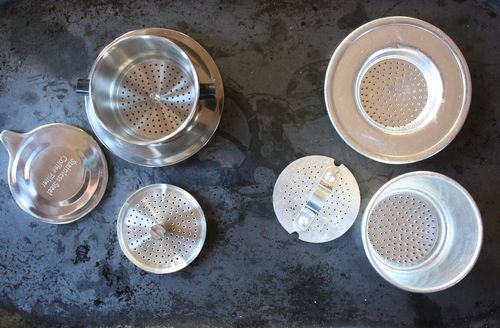
The photo above shows two popular designs. I used the one with the black plastic handles and screw-in screen, which is more familiar to people; it costs $3-5 each. The other kind does not have a screw-in screen or lid. It’s very lightweight and works fine, despite its extra flimsy construction. However, it is not as common in the U.S. I bought the one above in Melbourne, Australia.
When shopping at the store for a phin filter, remember that people often open the packages. Pick an unopened one and make sure the parts are all there and in working order.
“Buttery” coffee: If you’ve had coffee in Vietnam, you know it has a caramely fragrance. Whatever they tell you, it’s not real butter that’s added to the coffee. (Who can afford it over there for mass production?) According to Trung Nguyen, the leading coffee grower and exporter from Vietnam, there’s a touch of butter flavoring and cocoa in their Premium Blend, which actually worked perfectly for the brew. The added flavorings in the coffee impart the signature caramel-like edge to Vietnamese iced coffee.
Trung Nguyen’s Premium Blend is sold pre-ground in a can at a Chinese or Vietnamese market for about $8 (15 ounces); it’s also available online for about $14. They have a detailed website and bilingual (English and Chinese) instructions on the can for you to follow; there’s no Vietnamese on the can!
What if you don’t have the Vietnamese coffee? The typical fall-backs include Cafe du Monde, a dark French roast, or coffee with chicory, such as what’s sold at Trader Joe’s.
Sweetened condensed milk: For many Vietnamese-Americans, the go-to brand of condensed milk is Longevity/Old Man, sold at Chinese and Vietnamese markets. There are imposters but you’ll see the Old Man brand around.
There’s a gold version that contains a touch more fat. Grocery store sweetened condensed milk is fine too. You want the fat so read the label. No low-fat sweetened condensed milk if you’re looking to get the ultimate Vietnamese iced coffee.
Vietnamese Iced Coffee recipe: Bon Appetit editors Carla Lalli Music and Hunter Lewis went through the recipe, then had their test kitchen crew put my recipe and techniques through the paces. The magazine’s art department made this great shot to make you feel extra thirsty:
To locate the story and recipe, see pages 112 and 115 of the May issue, which is now off the newsstands. However, my Vietnamese iced coffee recipe is posted online.
As the weather heats up, Vietnamese iced coffee is a great way to start and/or continue on with your day. Take the time to use the filter, etc. to savor Vietnam. Then you’ll be ready to launch into whatever that’s ahead.
Related posts:
- High-tech Vietnamese coffee with the Aeropress
- How to make Vietnamese coffee (video by Eric Slatkin)
- History of Vietnamese coffee – links to photos, articles on the ca-phe history
(P.S. On the flip side, I wrote a story on Manresa Restaurant’s incredible cocktails for the Wall Street Journal. The article was published this past Saturday. The article is likely only accessible to subscribers. There may be other ways to access it. In any event, look for “Produce Driven Cocktails: Garden to Glass.” Shiso, aloe, and tamarind are among the ingredients used!)













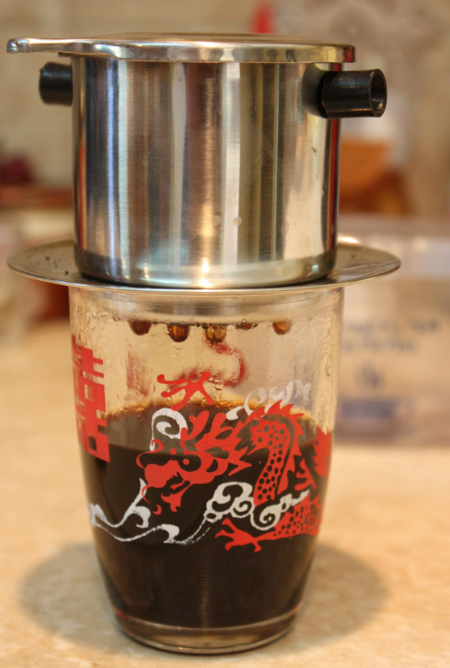
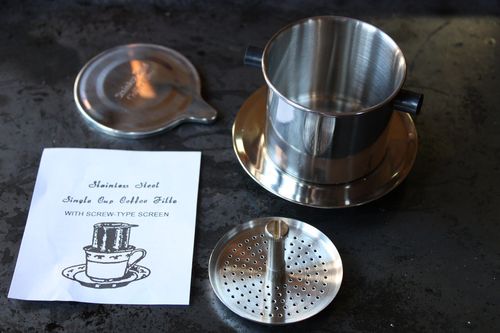
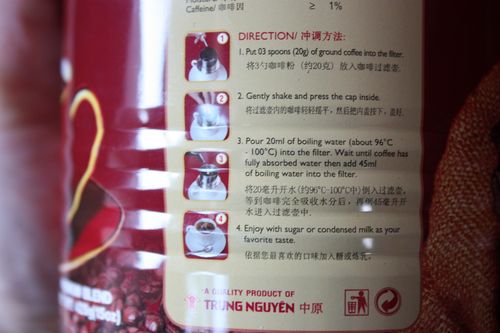
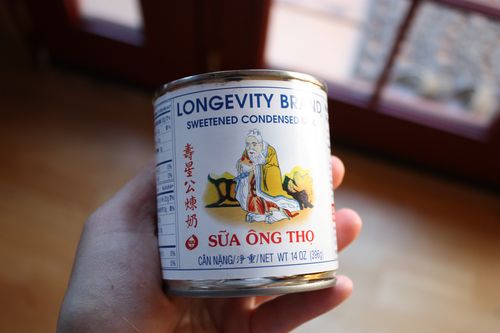
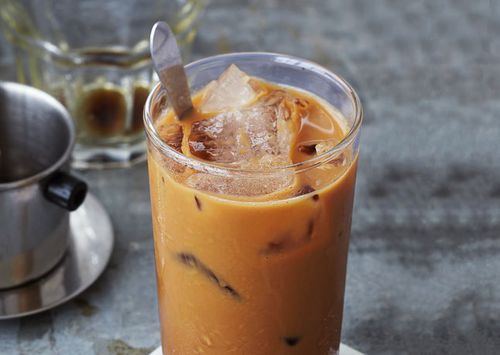




Katie says
It's funnny, I was trying to explain to my boyfriend why I need a phin filter yesterday. Generally I just use dark brewed coffee out of my french press and condensed milk.
Simon Bao says
Andrea, you've posted this on the same day as our first Excessive Heat Warning of 2012. 🙂
Those French filters are fine IF one is making ONLY a single cup of hot coffee, to turn into a single tall glass of iced coffee. But there's nothing odd about making an entire pot using your automatic drip coffee maker. Then just pour the coffee into a thermos where it stays all day, ready at an instant to make the next glass of iced coffee. Or, pour it into a pitcher and when it's cool enough, stick it in the fridge.
Butter coffee is not much of a taste sensation. It tastes like someone put butter in your coffee, which is what it originally was meant to be. And rather than purchasing Trung Nguyen's artificially flavored "butter coffee," one can always put real (unsalted) butter in one's own cup. But I think few will enjoy that.
If Cafe du Monde is not available, another fall back is Luzianne Dark Roast with Chicory. Like Cafe du Monde, it's a New Orleans style "French Roast" with chicory added.
Andrea Nguyen says
Katie, Hilarious. The phin filter is a funny thing. I love it because it's really old school but it's darn slow. For this application, it's the bomb. By the time the coffee's done, it's lukewarm and doesn't quickly dilute over ice. Genius, eh?
Andrea Nguyen says
True, Simon. But there's a certain evocative thing about making the single cup, waiting for the final drip with anticipation, then finally getting your payoff.
If people are after a certain Viet flavor, and that was the goal of the assignment, Trung Nguyen and similar types of coffee roasted in Vietnam, fits the bill. What's interesting to note is that I wouldn't drink Trung Nguyen's Premium Blend coffee black. It was harsh. But up against the milk, it was perfecto.
Thanks for the tips on other NOLA style coffee.
Lisa D says
I have to admidt...I cheat. I make cold brew coffee using my Toddy filter and keep it in a jug in the fridge. Every morning I pour my cold brew in a glass of ice and top it with sweetened condensed milk.
For a special treat...not exactly Vietnamse...I'll thin my sweetened condensed milk down with a little coconut milk for a more tropical flavor.
Chris says
I prefer the phin on the right. I picked up a few in Viet Nam, as I find the pressure of the upper filter on the coffee is just right, whereas with the screw-on one, it's easy to make it too tight and then you wait forever for the coffee.
Never thought of it as a "buttery" flavour; more like a chocolatey flavour, which as you mention, can come from a touch of cocoa added. Where I am, we can't get Trung Nguyen's Premium, only their Gourmet Blend, which strangely isn't nearly as tasty as their old House Blend, no longer available.
I agree with you that it has to have condensed milk, but many of the people I drink coffee with in VN would disagree, preferring cafe den da, with a spoonful of sugar. To me, it's a completely different beverage. Think I'll go make a glass of coffee now...
Yun Ho says
Hi Andrea:
Did you know that Vietnam is the second largest coffee-producing country in the world after Brazil? Vietnamese coffee beans are mostly robusta beans that are stronger in taste and with higher caffeine content. While arabica beans are more prized, French and Italians like to mix robusta beans to add more flavor to their coffee.
Ah, sweetened condensed milk brings back memories... I used to secretly suck on condensed milk can when I was a kid growing up in Saigon!!
Jon says
Great photos and excellent post. I use the phin model pictured on the left. Old Man not available here in Mexico so I make do with Nestle. Thanks for this post!
Andrea Nguyen says
Oh my, Lisa... coconut milk sounds great. Lookit, there are many coffee places in Vietnam that brew coffee in a large quantity. That's not a cheat but just a more modern way to brew.
Andrea Nguyen says
Chris -- The one on the right has its merits, I agree. The filter kind of floats more. It's made of aluminum? I got mine while traveling in Australia because I wanted a decent cup of coffee in the morning and didn't want to go out for it. I tracked down an Asian kitchen supply place and there it was... Then I had to bring it home with me!
Ca phe den da would be fine with lotsa ice. You and I are in the same boat on this. Go sua dac!
Andrea Nguyen says
Yep, Vietnam grows a bunch of coffee beans but the quality hasn't been high, hence it's often blended. It's a funny thing and they're trying to fix it. The coffee market is a lucrative one, these days.
As a kid, I love sweetened condensed milk on toast.
Andrea Nguyen says
Nestle is what we have in many American markets, often times with bilingual English/Spanish labels!
Linh-Dang says
Mmmm... one thing I'm deprived of living so far away from any Vietnamesetown is ready made iced coffee.
I've also heard from a coffeeshop owner in the old country that a teensy drop of fish sauce help immensely in bringing out the coffee flavor. Lately I learned in other cultures people stir with a stick of jerky or simply sprinkle a little bit of salt in their coffee.
Josh says
I have to ask; what is butter oil? How does one roast coffee, with a butter oil?
Jessica says
Coffee is a brewed beverage with a bitter flavor prepared from the roasted seeds of the coffee plant. Coffee is known to be one of the most refreshing beverages throughout the world. Whether it is a black coffee, or a coffe,with eual amount of milk, it is always the best companion,when yo are waiting for some one, or anything like this.
gano coffee, slimming coffee
Liv says
My grandfather used to own a coffee roasting plant in Vietnam and he actually used butter in the bean roasting process. According to my mom, it gave it a much better flavor than coffee roasted with salt water. Sadly, he lost everything after the fall to Communism.
Andrea Nguyen says
I think it's butter-flavored something, Josh. They don't elaborate...
Andrea Nguyen says
Liv, you're the first person to validate the use of butter! Sorry to hear of your grandfather's business being lost. So much of Viet culture suffered. Hopefully, things will change for the good as the country improves politically and economically.
Liv says
Got clarification from my mom- salted butter was used after the beans were roasted, not during. (In case anyone wants to try it at home) 😉
Margarita says
Looks really good. I think I'll have to whip up a batch this weekend. Thanks
Khanh Ho says
I heard that Vietnam is a top producer because it imports its beans from Laos, processes them and ships them as the putative country of origin. Of course, I heard this in Laos...
plumbing fittings says
Iced coffee is very in demand in Asia. It has been a people's favorite breakfast, sometimes ice cream is toppings on iced coffee.
daniel says
I recently “discovered” cafe sua da and love it. I have tried to recreate at home and have not been having success; I just can’t get that same great strong flavor. It seems like I am getting a cup of caffeine that upsets my stomach more than anything. For such a simple device, I think I just haven’t mastered the phin yet. I recently tried to really tighten the filter and that gave me a better cup, but still a little to much caffeine and after almost 10 minutes only half the water had gone through the coffee. I will keep experimenting on getting the right “tamping” of the coffee but not so tight the water doesn’t do it’s job…..but I would love some tips if you have any. For coffee I have used the Trung Nguyen gourmet blend and premium blend and have tried mixing in some espresso roast ground as well.
Kasper Moeller says
Dear Andrea
After having visited Vietnam a few times I wanted to create an authentic cà phê sữa đá here in Denmark. I got a hold of Trung Nguyen's premium brand and am using that as the base of coffee brewing. I have tried making cold brew by simply mixing coffee grounds and water and leaving it in the fridge for 24 hours, I've tried adding coffee grounds to boiling water and then leaving it in the fridge for 24 hours, and I have also tried the phin. However none of the methods came out exactly like the iced coffee that is served from a street stall in Vietnam. As I recall, they often pour out pre made coffee from a coke plastic bottle and mix it with condensed milk and lots of ice. My question is: Howcome that coffee from the plastic coke bottle is almost like a syrup and (sometimes) has an after-taste of burnt rubber? I usually prefer my own brew over the street stall one in vietnam, but which is most authentic? Ohh and how would you prepare a large quantity of coffee so that it is ready for making iced coffee, cold brew, hot brew, filter coffee or... 😉
Any answer will be highly appreciated.
Best regards
Kasper Moeller
Andrea Nguyen says
Hello Kasper -- How funny and interesting. My initial thought about the Coke bottles of premade coffee is that they prepared a concentrate and perhaps put sugar syrup in the coffee, thereby having to use less condensed milk -- or maybe evaporated milk instead of condensed milk. The burnt rubber tire taste could come from the coffee itself. I'm no expert but maybe the vendors use a lesser quality bean.
Authenticity is a slippery slope because there's a certain inky, earthy flavor and caramel sweetness to Vietnamese coffee. It varies and my take is that the best Viet coffee is the one you like most. It's subjective but if you stick to the fundamentals, you've got Viet-style coffee that suits your taste. That's authentic enough for me!
Large quantity coffee -- I don't know as I've never made it to drink later. Sorry.